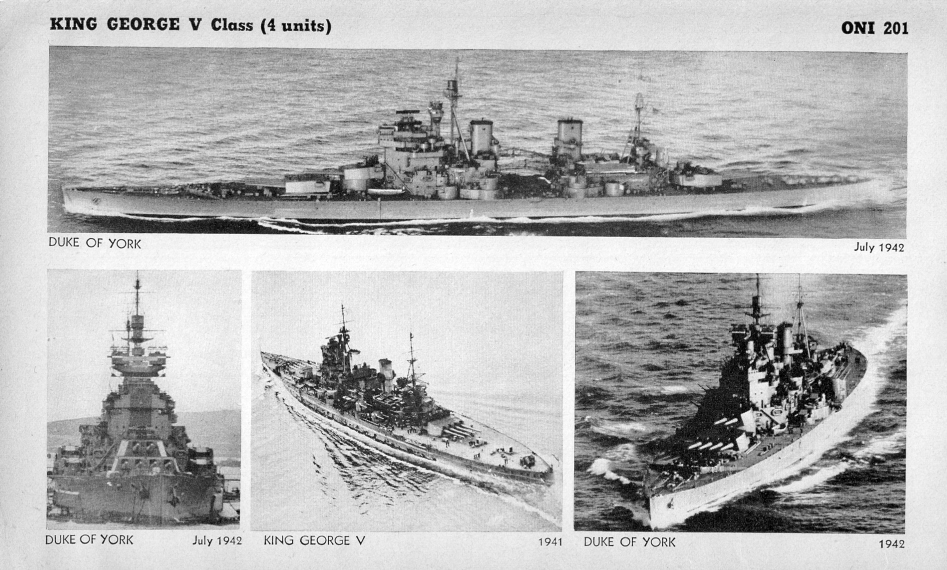HMS King George V (BB-13)
Royal Navy Battleship of World War Two
By Stephen Sherman, June, 2007. Updated March 1, 2012.
The King George V class
battleships (KGV) were completed for the Royal Navy early in World War
Two. Five ships of the
class were built: King George V
(1940), Prince of Wales
(1941), Duke of York (1941),
Howe (1942), and
Anson (1942). They carried one
quadruple and one high "super-firing" twin turret forward and one
quadruple turret
aft. In this unique layout, she carried ten 14-inch guns. Her secondary
armament consisted of sixteen 5.25 inch guns clustered amidships in
eight double turrets.
Two
widely spaced tall, flat-sided stacks distinguished the ships of this
class. Designed by the Admiralty in 1936 under the restrictions of the
Washington Treaty. She was laid down at the Walker Navy Yard,
Newcastle-upon-Tyne by Vickers-Armstrong Ltd. Originally, she was to
have been named HMS King George VI
following the tradition of naming the first capital ship of a new reign
after the monarch. The King requested that the ship be named in honour
of his late father, King George V, after whom an earlier class of
battleships had been named in 1911. A later member of this class of
battleship was named HMS Duke of York
in honour of the King instead.

Her main armament of ten 14 inch main guns in three turrets, was
relatively weaker than the 16-inch guns mounted by HMS
Nelson and
Rodney, or the 15-inch guns of
Bismarck or
Tirpitz. After supporting the
Lofoten Islands commando raids on March 4, 1941,
King George V became the flagship
of the Home Fleet under Admiral Sir John Tovey. In late May she was
involved in the pursuit of Bismarck,
and on the morning of the 27th, she and
Rodney poured endless rounds into
the doomed battleship. Earlier in the chase, lack of fuel had forced
home Prince of Wales and
aircraft carrier Victorious,
but destruction of the German ship was of such paramount importance to
Prime Minister Winston Churchill that he ordered the following
extraordinary—and irresponsible—message sent: "We cannot visualize the
situation from your signal. Bismarck
must be sunk at all costs and if to do this it is necessary for
King George V to remain on the
scene she must do even if it subsequently means towing
King George V." As it happened, the
message was not received until after Bismarck
was sunk, and Tovey later asserted that he would have ignored it anyway.
While escorting convoy PQ-15 to Murmansk on 1 May 1942,
King George V collided with the
destroyer HMS Punjabi,
resulting in the sinking of the latter ship with 49 crew, and bow
damage to the battleship.
In 1943 she was temporarily detached to duties in the Mediterranean,
and was involved in the invasion of Sicily and attack on Taranto, as
well as transporting
the Prime Minister, Winston Churchill, back to Britain from the Tehran
Conference. From 1944 until the surrender of Japan,
King George V served with the
British Pacific Fleet, and was present off Japan during the official
surrender ceremony.

In 1944 she was redeployed to the new British Pacific Fleet as the
flagship of the fleet's second-in-command, Rear Admiral Sir Bernard
Rawlings. Although both she and her sister ship HMS
Howe had a much reduced role
compared with the North Atlantic campaign, often providing
anti-aircraft cover for the fleet's aircraft carriers, they were both
involved in the bombardments of Okinawa and southern Honshu, where the
King George V last fired her main
armament in anger.
Following the end of World War Two, the battleships of the
King George V Class had become
obsolete and expensive to run. Refitted in 1946/47, she was reduced to
a training role in Portland. In 1950 the class was laid up in reserve
in Gareloch. After the scrapping of the class was approved in 1957, she
was broken up at Dalmuir and Troon the following year.
